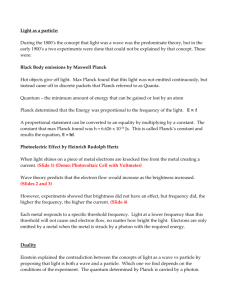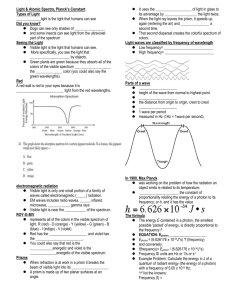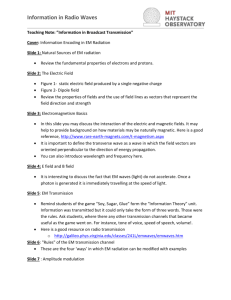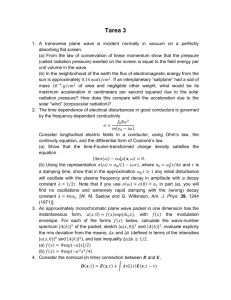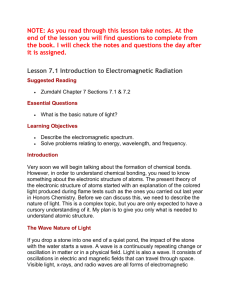Planck Formula Derivation: Black-Body Radiation
advertisement
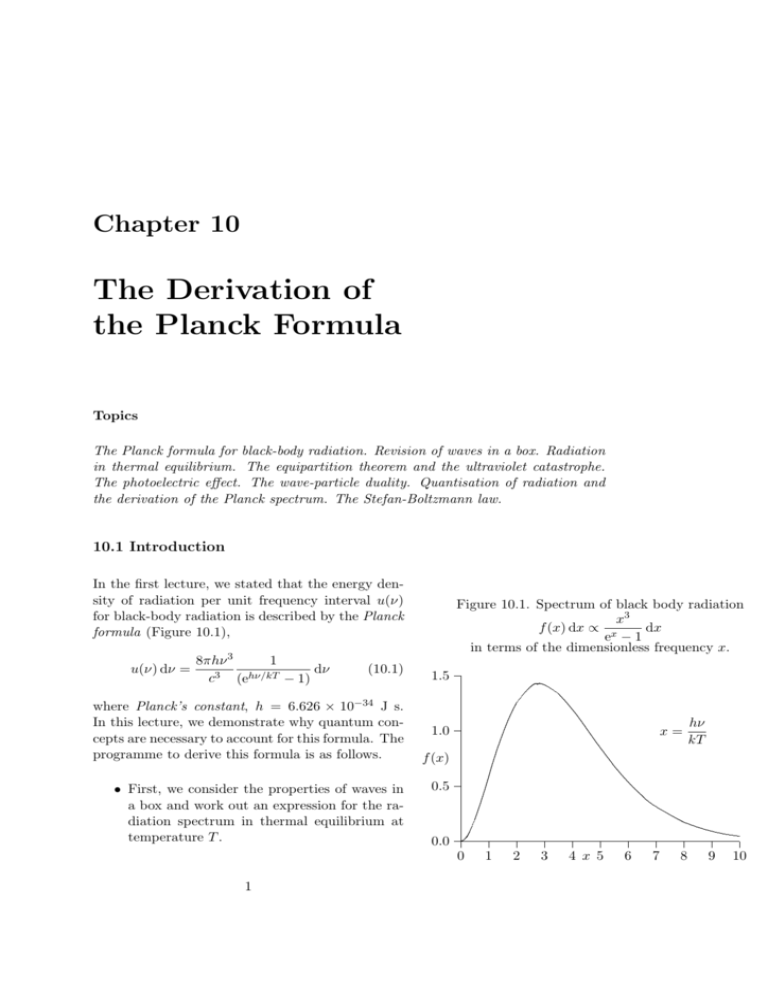
Chapter 10 The Derivation of the Planck Formula Topics The Planck formula for black-body radiation. Revision of waves in a box. Radiation in thermal equilibrium. The equipartition theorem and the ultraviolet catastrophe. The photoelectric effect. The wave-particle duality. Quantisation of radiation and the derivation of the Planck spectrum. The Stefan-Boltzmann law. 10.1 Introduction In the first lecture, we stated that the energy density of radiation per unit frequency interval u(ν) for black-body radiation is described by the Planck formula (Figure 10.1), u(ν) dν = 8πhν 3 1 dν 3 hν/kT c (e − 1) (10.1) where Planck’s constant, h = 6.626 × 10−34 J s. In this lecture, we demonstrate why quantum concepts are necessary to account for this formula. The programme to derive this formula is as follows. • First, we consider the properties of waves in a box and work out an expression for the radiation spectrum in thermal equilibrium at temperature T . Figure 10.1. Spectrum of black body radiation x3 f (x) dx ∝ x dx e −1 in terms of the dimensionless frequency x. 1.5 1.0 f (x) 0.5 0.0 ..................... ..... ..... ...... .... ..... ... . . ..... ... ... ... ... . ... .. . ... .. ... . ... .. . ... .. . ... .. ... . ... .. . ... .. . ... .. ... . ... .. . ... ... .... . ... . ... .... ... . ... . ... .... .... . ..... . ..... .... ..... . . ..... ..... .... .... ... ..... . . ..... ..... .... ..... . ...... . ...... .. . ....... . . ........ . ......... .. . .......... .. ............ . ................. .. . ...... .. . . . .... x= 0 1 1 2 3 4 x 5 6 7 8 hν kT 9 10 The Derivation of the Planck Formula 2 • Application of the law of equipartition of energy leads to the ultraviolet catastrophe, which shows that something is seriously wrong with the classical argument. • Then, we introduce Einstein’s deduction that light has to be quantised in order to account for the observed features of the photoelectric effect. • Finally, we work out the mean energy per mode of the radiation in the box assuming the radiation is quantised. This leads to Planck’s radiation formula. This calculation indicates clearly the necessity of introducing the concepts of quantisation and quanta into physics. 10.2 Waves in a Box - Revision Let us revise the expression for an electromagnetic (or light) wave travelling at the speed of light in some arbitary direction, say, in the direction of the vector r. If the wave has wavelength λ, at some instant the amplitude of the wave in the r-direction is A(r) = A0 sin 2πr λ (see Figure 10.2). In terms of the wave vector k, we can write A(r) = A0 sin(k · r) = A0 sin kr, where |k| = 2π/λ. Wave vectors will prove to be very important quantities in what follows. The wave travels at the speed of light c in the r-direction and so, after time t, the whole wave pattern is shifted a distance ct in the positive r-direction and the pattern is A0 sin kr0 , where we have shifted the origin to the point ct along the r-axis such that r = r0 + ct. Thus, the expression for the wave after time t is A(r, t) = A0 sin kr0 = A0 sin(kr − kct). But, if we observe the wave at a fixed value of r, we observe the amplitude to oscillate at frequency ν. Therefore, the time dependence of the wave amplitude is sin(2πt/T ) where T = ν −1 is the period of oscillation of the wave. Therefore, the time dependence of the wave at any point Figure 10.2. The properties of sine and cosine waves. The Derivation of the Planck Formula 3 is sin ωt, where ω = 2πν is the angular frequency of the wave. Therefore, the expression for the wave is A(r, t) = A0 sin(kr − ωt), and the speed of the wave is c = ω/k. 10.3 Electromagnetic Modes in a Box – More Revision Consider a cubical box of side L and imagine waves bouncing back and forth inside it. The box has fixed, rigid, perfectly conducting walls. Therefore, the electric field of the electromagnetic wave must be zero at the walls of the box and so we can only fit waves into the box which are multiples of half a wavelength. The first few examples are shown in Figure 10.3. In the x-direction, the wavelengths of the waves which can be fitted into the box are those for which lλx =L 2 where l takes any positive integral value, 1, 2, 3, . . . . Similarly, for the y and z directions, mλy = L and 2 nλz = L, 2 where m and n are also positive integers. The expression for the waves which fit in the box in the x-direction is A(x) = A0 sin kx x Now, kx = 2π/λx where kx is the component of the wave-vector of the mode of oscillation in the x-direction. Hence, the values of kx which fit into the box are those for which λx = 2L/l and so kx = 2πl πl = , 2L L where l takes the values l = 1, 2, 3 . . . . Similar results are found in the y and z directions: ky = πm , L kz = πn . L Let us now plot a three-dimensional diagram with axes kx , ky and kz showing the allowed values of kx , ky and kz . These form a regular cubical array of points, each of them defined by the three integers, l, m, n (Figure 10.4). This is exactly the same as the velocity, or momentum, space which we introduced for particles. Figure 10.3. Waves which can be fitted into a box with perfectly conducting walls. The Derivation of the Planck Formula 4 The waves can oscillate in three dimensions but the components of their k-vectors, kx , ky and kz , must be such that they are associated with one of the points of the lattice in k-space. A wave oscillating in three dimensions with any of the allowed values of l, m, n satisfies the boundary conditions and so every point in the lattice represents a possible mode of oscillation of the waves within the box, consistent with the boundary conditions. Thus, in three-dimensions, the modes of oscillation can be written A(x, y, z) = A0 sin(kx x) sin(ky y) sin(kz z) (10.2) To find the relation between kx , ky , kz and the angular frequency ω of the mode, we insert this trial solution into the three-dimensional wave equation ∂2A ∂2A ∂2A 1 ∂2A + + = . ∂x2 ∂y 2 ∂z 2 c2 ∂t2 (10.3) The time dependence of the wave is also sinusoidal, A = A0 sin ωt and so we can find the dispersion relation for the waves, that is, the relation between ω and kx , ky , kz , by substituting the trial solution into (10.3); |k|2 = (kx2 + ky2 + kz2 ) = ω2 . c2 where k is the three-dimensional wave-vector. Now, k 2 = kx2 + ky2 + kz2 = π2 2 (l + m2 + n2 ), L2 and so ω2 π2 2 π 2 p2 2 2 = (l + m + n ) = , c2 L2 L2 (10.4) where p2 = l2 + m2 + n2 . 10.4 Counting the Modes We now return to statistical physics. We need the number of modes of oscillation in the frequency interval ν to ν + dν. This is now straightforward, since we need only count up the number of lattice points in the interval of k-space k to k + dk corresponding to ν to ν + dν. We carried out a similar calculation in converting from dvx dvy dvz to 4πv 2 dv. Figure 10.4. Illustrating the values of l and m which result in components of wavevectors which can fit in the box. The Derivation of the Planck Formula 5 In Figure 10.4, the number density of lattice points is one per unit volume of (l, m, n) space. We are only interested in positive values of l, m and n and so we need only consider one-eighth of the sphere of radius p. The volume of a spherical shell of radius p and thickness dp is 4πp2 dp and so the number of modes in the octant is µ ¶ 1 dN (p) = N (p) dp = 4πp2 dp. 8 Note on the Polarisation of Electromagnetic Waves Since k = πp/L and dk = π dp/L, we find dN (p) = L3 2 k dk. 2π 2 But, L3 = V is the volume of the box and k = 2πν/c. Therefore, we can rewrite the expression dN (p) = V 2 V 8π 3 ν 2 4πν 2 V k dk = dν = dν 2π 2 2π 2 c3 c3 Finally, for electromagnetic waves, we are always allowed two independent modes, or polarisations, per state and so we have to multiply the result by two. Because of the nature of light waves, there are two independent states associated with each lattice point (l, m, n). The final result is that the number of modes of oscillation in the frequency interval ν to ν + dν is 8πν 2 V dν dN = c3 Thus, per unit volume, the number of states is dN = 8πν 2 dν c3 (10.5) This is a really important equation. 10.5 The Average Energy per Mode and the Ultraviolet Catastrophe We now introduce the idea that the waves are in thermodynamic equilibrium at some temperature T . We showed that, in thermal equilibrium, we award 12 kT of energy to each degree of freedom. This is because, if we wait long enough, there are Illustrating the electric and magnetic fields of an electromagnetic wave. The E and B fields of the wave are perpendicular to each other and to the direction of propagation of the wave. There is an independent mode of propagation in which E and B are rotated through 90◦ with respect to the direction of propagation C. Any polarisation of the wave can be formed by the sum of these two independent modes of propagation. The Derivation of the Planck Formula 6 processes which enable energy to be exchanged between the apparently independent modes of oscillation. Thus, if we wait long enough, each mode of oscillation will attain the same average energy E, when the system is in thermodynamic equilibrium. Therefore, the energy density of radiation per unit frequency interval per unit volume is 8πν 2 E dν, c3 8πν 2 u(ν) = 3 E. c du = u(ν) dν = Now, we established in Section 8.2 that the average energy of a harmonic oscillator in thermal equilibrium is E = kT and so the spectrum of black-body radiation is expected to be u(ν) = 8πν 2 8πν 2 kT E = . c3 c3 (10.6) This result is very bad news – the energy density of radiation diverges at high frequencies. Einstein expressed this result forcibly – Z ∞ Z ∞ 8πν 2 kT u(ν) dν = dν → ∞. c3 0 0 This is the famous result known as the ultraviolet catastrophe – the total energy in black-body radiation diverges. This expression for the spectral energy distribution of radiation is known as the Rayleigh-Jeans Law and, although it diverges at high frequencies, it is in excellent agreement with the measured spectrum at low frequencies and high temperatures. This result was derived by Lord Rayleigh in 1900. This was one of the key problems of classical physics – what has gone wrong? 10.6 The Photoelectric Effect – Revision The solution was contained in Einstein’s revolutionary paper of 1905 in which he proposed that, under certain circumstances, light should be regarded as consisting of The Rayleigh-Jeans Law u(ν) = 8πν 2 kT . c3 The Ultraviolet Catastrophe According to classical physics, the energy density of black-body radiation diverges at high frequencies Z ∞ 8πν 2 kT dν → ∞. c3 0 The Derivation of the Planck Formula 7 a flux of particles, what we now call photons, each with energy hν, where h is Planck’s constant. He discovered this result from a remarkable analysis of the thermodynamics of radiation in the Wien region of the black-body spectrum. Among the consequences of this proposal was an explanation for various puzzling features of the photoelectric effect. If optical or ultraviolet radiation is incident upon a surface, electrons are ejected, provided the frequency of the radiation is high enough. When monochromatic light, that is, light of a single frequency, is shone upon the cathode of a discharge tube, it was found that a current flowed between the cathode and the anode, associated with the drift of the ejected electrons to the anode. In the arrangement shown in Figure 10.5, the electrostatic potential between the anode and cathode could be made positive or negative. When it is positive, the electrons are accelerated while if it is negative the electrons are decelerated and the current flow reduced. At a sufficently negative voltage V0 , the current goes to zero – V0 is called the stopping potential (Figure 10.6). One of the puzzling aspects of the photoelectric effect was that, no matter what the intensity of the incident monochromatic radiation, the stopping voltage was always the same. We can rephrase this result in the following way. The kinetic energy, which the electrons acquire on being ejected from the surface, has a maximum value which is independent of the intensity of the radiation. Figure 10.5. Illustrating the apparatus needed to study the energies of electrons emitted in the photoelectric effect. Einstein could account for this result by adopting his light-quantum hypothesis. Suppose a certain energy W0 is required to remove an electron from the surface of the material – W0 is known as its work function. Then, by conservation of energy, any excess energy once the electron is liberated appears as its kinetic energy 12 me v 2 , that is, hν = W0 + 12 me v 2 But the maximum kinetic energy of the ejected electrons can be found from the stopping voltage V0 since the current ceases to flow when 21 me v 2 = eV0 . Einstein therefore predicted the relation hν = W0 + eV0 Hence, if we plot V0 against ν, we should obtain a linear relation e W0 ν = V0 + h h According to Einstein’s picture, increasing the intensity of the light increases the number of electrons of energy 1 2 2 me v but not their individual energies. When Einstein Figure 10.6. Illustrating the determination of the stopping voltage for the photoelectric effect. Notice that, although the intensity of radiation is greater in experiment (b) than in (a), the stopping voltage V0 is unchanged. The Derivation of the Planck Formula 8 derived this result, the dependence of V0 upon ν was not known. Let us demonstrate the photoelectric effect experimentally using the apparatus shown in the Figure 10.7. The source of light is a mercury lamp – the mercury vapour emits five strong emission lines which span the frequency range from ultraviolet to yellow wavelengths, as listed in Table 10.1. The apparatus is arranged so that these lines are dispersed and a photoelectric detector used to measure the energies of the liberated electrons. Table 10.1 shows the results of a typical experiment, which are plotted in Figure 10.8. The slope of the line enables the value of h/e to be determined. In this experiment, the line is described by V0 = 2 ν + constant, 4.9 × 1014 h = 0.408 × 10−14 J s C−1 . e The actual value of h/e is 0.414 × 10−14 J s C−1 . It took many years before the correctness of Einstein’s theory was established. The definitive results concerning the photoelectric effect were published by Millikan in 1916. This was the first example of the fundamental phenomenon in physics known as the wave-particle duality. It is the statement that, in physics, waves have particle properties and, as we will show in Chapter 11, particles have wave properties. This lies at the very heart of quantum mechanics and leads to all sorts of non-intuitive phenomena. Historical Note Here are Millikan’s words from 1916. Figure 10.7. The apparatus used to demonstrate the frequency dependence of the photoelectric effect. Table 10.1. The Photoelectric Effect Line Frequency Stopping Voltage ×1014 Hz Volts UV2 8.22 1.807 UV1 7.41 1.546 Blue 6.88 1.359 Green 5.49 0.738 Yellow 5.19 0.624 Figure 10.8. The Frequency-Stopping Voltage Relation (linear scales) 2.0 • • • Stopping Voltage V0 ‘We are confronted, however, by the astonishing situation that these facts were correctly and exactly predicted 9 years ago by a form of quantum theory which has now generally been abandoned.’ 0 He also refers to Einstein’s ‘bold, not to say reckless hypothesis of an electromagnetic light corpuscle of energy hν which flies in the face of the thoroughly established facts of interference.’ .................................................................................................................................................................................................. ... .. .... .. .... ... ... .... ... ... .. ... ... . .. ... ... . .. ... . ... .. ... . ... . . . ... ... ... ... ... . .. . ... ... .. . ... ... .. . ... ... .. . ... ... . . . ... ... ... ... ... . .. ... ... . .. ... ... . .. . ... ... .. . ... ... . . . ... ... ... ... ... . .. ... ... . .. ... ... . .. ... ... . .. ... ... . . . . ... ... ... ... ... . .. ... ... . .. ... ... . .. ... ... . .. ... ... . .. ... ... . . . ... . ... ... ... . ... .. . ... .. ...................................................................................................................................................................................................... V0 ∝ ν • • 1 10 Frequency/1014 Hz The Derivation of the Planck Formula 9 10.7 Derivation of Planck’s law The photoelectric effect demonstrates that light waves have particle properties and that the light quanta, or photons, of a particular frequency ν each have energy hν. We need to reconcile this picture with the classical picture of electromagnetic waves in a box. In the classical picture, the energy associated with the waves is stored in the oscillating electric and magnetic fields. We found it necessary to impose the constraint that only certain modes are permitted by the boundary conditions – the waves are constrained to fit into the box with whole numbers of half wavelengths in the x, y, z directions. Now we have a further constraint. The quantisation of electromagnetic radiation means that the energy of a particular mode of frequency ν cannot have any arbitrary value but only those energies which are multiples of hν, in other words the energy of the mode is E(ν) = nhν, where we associate n photons with this mode. We now consider all the modes (and photons) to be in thermal equilibrium at temperature T . In order to establish equilibrium, there must be ways of exchanging energy between the modes (and photons) and this can occur through interactions with any particles or oscillators within the volume or with the walls of the enclosure. We now use the Boltzmann distribution to determine the expected occupancy of the modes in thermal equilibrium. The probability that a single mode has energy En = nhν is given by the usual Boltzmann factor p(n) = exp (−En /kT ) ∞ X , (10.7) exp (−En /kT ) n=0 where the denominator ensures that the total probability is unity, the usual normalisation procedure. In the language of photons, this is the probability that the state contains n photons of frequency ν. The mean energy of the mode of frequency ν is The Derivation of the Planck Formula 10 therefore ∞ X Eν = ∞ X En p(n) = n=0 En exp (−En /kT ) n=0 ∞ X exp (−En /kT ) n=0 ∞ X = nhν exp (−nhν/kT ) n=0 ∞ X (10.8) exp (−nhν/kT ) n=0 To simplify the calculation, let us substitute x = exp(−hν/kT ). Then (10.8) becomes ∞ X Eν = hν nxn n=0 ∞ X = hν xn (x + 2x2 + 3x3 + . . . ) , (1 + x + x2 + . . . ) n=0 = hν x (1 + 2x + 3x2 + . . . ) . (1 + x + x2 + . . . ) (10.9) Now, we remember the following series expansions: 1 = 1 + x + x2 + x3 + . . . (1 − x) 1 = 1 + 2x + 3x2 + . . . (1 − x)2 (10.10) (10.11) Hence, the mean energy of the mode is hν hν hν x = −1 = hν/kT E= . 1−x x −1 e −1 (10.12) This is the result we have been seeking. To find the classical limit, we allow the energy quanta hν to tend to zero. Expanding ehν/kT − 1 for small values of hν/kT , µ ¶ hν 1 hν 2 hν/kT e −1=1+ + + · · · − 1. kT 2! kT Thus, for small values of hν/kT , ehν/kT − 1 = hν kT Note (10.11) can be found from (10.10) by differentiation with respect to x. Average energy of a mode of frequency ν according to quantum theory E= hν ehν/kT −1 . The Derivation of the Planck Formula 11 and so E= hν ehν/kT −1 = hν = kT ²/kT Thus, if we take the classical limit, we recover exactly the expression for the average energy of a harmonic oscillator in thermal equilibrium, E = kT . We can now complete the determination of Planck’s radiation formula. We have already shown that the number of modes in the frequency interval ν to ν + dν is (8πν 2 /c3 ) dν per unit volume. The energy density of radiation in this frequency range is 8πν 2 Eν dν c3 8πhν 3 1 = dν. 3 c exp (hν/kT ) − 1 The Planck distribution in terms of the energy density of radiation per unit frequency interval u(ν) dν = 8πhν 3 1 dν 3 c exp (hν/kT ) − 1 u(ν) dν = (10.13) This is the Planck distribution function. 10.8 The Stefan-Boltzmann Law Let us demonstrate experimentally how the total intensity of radiation depends upon temperature. By the total intensity, we mean the total amount of energy emitted by the hot body summing over all frequencies. This experiment was first carried out by John Tyndell at the Royal Institution in London in 1870 and repeated more precisely in Vienna by Josef Stefan who showed empirically that the intensity of radiation was proportional to the fourth power of the temperature I ∝ T 4, where I is the radiant energy emitted per second per unit area by the hot body. We can demonstrate this law by placing a bolometer, which is a detector which measures the total amount of energy incident upon it, close to a light bulb (Figure 10.9). The temperature of the light bulb filament can be measured because of the strong correlation between its resistance and temperature (Table 10.2). Figure 10.9. The Tungsten Light Bulb Bolometer Detector .. ....... R........... .... ..... ..... ..... . . . .... . ..... ... ..... ... ..... ..... ... .... . . . . ... .... ... ..... ... ......... ... .. ........................................................................ ... T .................................................................... .... ........... ... ... ... ... ... ... ... ............. ....................................................................... .. ... ... ... .... ... ... ... ... ... .. ... ............... ............... . .. ................................... ........................................................................................ ... ... .. .. ... ... .... .... ... ... ... ... . ... . . . . ... ........... ... . . .. . ... . . . . . . . . . . . . . . . . . . . . .. ..... . ... ... .... ............... ..... . ... ... ... ... .... ..................................... .... .... ... ... .. ... .... ... ... ... ... ... .... ... ... ...... ........................ ... ... .... .... ... .. ................................... ..................................... ... ... .... ... .. ... ............... . ... . ... ..... ... ..... ...... ... ........ ... .. . ... . ... ... ... .. ...................................................... ....... .. V • • I The Derivation of the Planck Formula 12 The incident radiation heats a semiconducting diode and the rate of absorption of energy is measured by the voltage output of the bolometer. Table 10.3 shows a set of data which were obtained in an earlier experiment. These data are plotted in the loglog plot in Figure 10.10. It can be seen that these data are well described by the relation I ∝ T 4 . Let us compare this law with the prediction of the quantum theory of the black-body spectrum by integrating the Planck spectrum over all wavelengths to find the dependence of the total energy density of radiation u upon temperature. Z ∞ u= u(ν) dν 0 Z 8πh ∞ ν 3 dν . = 3 c ehν/kT − 1 0 Voltage V 3.0 6.0 8.0 10.0 12.0 Therefore, µ u= 8π 5 k 4 15c3 h3 2.0 T 4 = aT 4 . ................................................................................................................................................................................................. .. . .... ... ... ... ... ... ... ... ... ... ... ... ... ... . . . ... . ... .... . . . ... . ... ... . . . ... . ..... ... .... ..... ... ... ..... ..... ... ... .... . . . ... ... . ... . . . ... ... . ... . . . ... ... . ... . . . ... ... . .... . . ... ... . ... . . . ... ... . ... . . . ... ... . ... . . . ... ... . ... . . . ... ... . ... . . . ... ... . .... . . ... ... . ... . . . ... ... . ... . . . ... ... . ... . . . ... ... . ... . . . ... ... . .... . . ... . ... ... . . . ... ... . ... . . . . ... ... ... . . . . ... ... ... . . . . ... ... ... . . . . ... ... .... . . . ... .. .. ...................................................................................................................................................................................................... • • • log I a = 7.566 × 10−16 J m−3 K−4 . We can now relate this energy density to the energy emitted per second from the surface of a black body maintained at temperature T . Because the enclosure is in thermal equilibrium, we can use the relations derived from kinetic theory to work out the rate of arrival of photons per unit area. The flux of photons is 14 N v = 14 N c, since all the photons travel at the speed of light, where N is their number density. Therefore, the rate at which energy arrives at 1 7.92 11.59 13.33 14.89 16.39 Figure 10.10. The Intensity–Temperature Relation ¶ We have derived the Stefan-Boltzmann law for the energy density of black-body radiation. Putting in the constants, we find R/R0 Table 10.3 Temperature Intensity of K radiation (V) 293 1622 2.3 2265 8.8 2572 15.6 2846 23.9 3109 32.8 Now, change variables to x = hν/kT so that dx = (h/kT ) dν. Then, µ ¶ Z 8πh kT 4 ∞ x3 dx u= 3 . c h ex − 1 0 The integral is a standard integral, the value of which is Z ∞ 3 π4 x dx = . x e −1 15 0 Table 10.2 Current Resistance I R = V /I 0.36 1.06 2.83 1.45 4.14 1.68 4.76 1.88 5.32 2.05 5.85 I∝ T4 • • 0 3.0 3.5 log T Temp. (K) 293 1622 2265 2572 2846 3109 The Derivation of the Planck Formula 13 the walls per second, and consequently the rate at which the energy must be re-radiated from them, is 14 N hνc = 14 uc since u = N hν. Therefore, I= 1 4 uc ac = T 4 = σT 4 = 4 µ 2π 5 k 4 15c2 h3 ¶ T4 This provides a derivation of the value of the StefanBoltzmann constant in terms of fundamental constants µ 5 4¶ ac 2π k = 5.67 × 10−8 W m−2 K−4 σ= = 4 15c2 h3 10.9 Summary We have made enormous progress. We have introduced quantisation, quanta and the first example of the wave-particle duality. The key idea is that we cannot understand the form of the black-body spectrum without introducing the idea that light consists of energy packets, photons, with energies E = hν. Two forms of the Stefan-Boltzmann Law In terms of the energy density of blackbody radiation µ 5 4¶ 8π k 4 u = aT = T 4, 15c3 h3 where a = 7.566 × 10−16 J m−3 K−4 . In terms of the energy emitted per unit surface area of a black-body µ 5 4¶ 2π k 4 I = σT = T4 15c2 h3 where σ = 5.67 × 10−8 W m−2 K−4 . The Derivation of the Planck Formula 14 Non-examinable optional extra Since the energy of each photon is hν, the result E= hν ehν/kT − 1 determines the average number of photons in a single mode of frequency ν in thermal equilibrium nν = 1 . exp (hν/kT ) − 1 This is called the photon occupation number in thermal equilibrium. We see that at high frequencies and low temperatures, hν/kT À 1, the occupation number is exp (−hν/kT ), which is just the standard Boltzmann factor. At low frequencies and high temperatures, however, the occupation number becomes kT /hν. Evidently, there is much more to photon statistics than has been apparent from our elementary treatment. Let us reorganise the expression for the number density of photons of different frequencies in the light of our considerations of the form of the Boltzmann distribution. We recall that the distribution has two parts, the Boltzmann factor and the degeneracy of the energy state. Let us rewrite the Planck distribution in terms of the number density of photons in the frequency interval dν. N (ν) dν = u(ν) dν 8πν 2 dν 1 = . hν c3 ehν/kT − 1 Now, multiply above and below by h3 : N (ν) dν = 8π h3 =2× µ hν c ¶2 µ d hν c ¶ 1 , ehν/kT − 1 1 4πp2 dp × hν/kT . 3 h e −1 where p = hν/c is the momentum of the photon. This is a deep result. The term 4πp2 dp is the differential volume of momentum space for the photons which have energies in the range hν to h(ν + dν). The factor two corresponds to the two polarisation states of the photon (or electromagnetic wave). The h3 is the elementary volume of phase space and so the term 4πp2 dp/h3 tells us how many states there are available in the frequency interval dν. The final term is the photon occupation number which we derived above.




